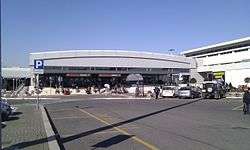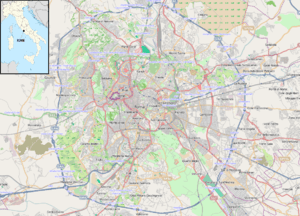Ciampino–G. B. Pastine International Airport
| Ciampino–G. B. Pastine International Airport Ciampino–Aeroporto Internazionale G. B. Pastine | |||||||||||
|---|---|---|---|---|---|---|---|---|---|---|---|
 | |||||||||||
| IATA: CIA – ICAO: LIRA | |||||||||||
| Summary | |||||||||||
| Airport type | Public / Military | ||||||||||
| Operator | Aeroporti di Roma | ||||||||||
| Serves | Rome, Italy | ||||||||||
| Location | Ciampino, Lazio | ||||||||||
| Elevation AMSL | 427 ft / 130 m | ||||||||||
| Coordinates | 41°47′58″N 012°35′50″E / 41.79944°N 12.59722°ECoordinates: 41°47′58″N 012°35′50″E / 41.79944°N 12.59722°E | ||||||||||
| Website |
www | ||||||||||
| Map | |||||||||||
 CIA Location of airport on map of Rome Location of airport on map of Lazio  CIA Location of Lazio region in Italy  | |||||||||||
| Runways | |||||||||||
| |||||||||||
| Statistics (2015) | |||||||||||
| |||||||||||
Ciampino–G. B. Pastine International Airport (Italian: Ciampino–Aeroporto Internazionale G. B. Pastine) (IATA: CIA, ICAO: LIRA) or simply Rome Ciampino Airport, is the secondary international airport of Rome, the capital of Italy, behind Leonardo da Vinci–Fiumicino Airport. It is a joint civilian, commercial and military airport situated 6.5 NM (12.0 km; 7.5 mi) south southeast[1] of central Rome, just outside the Greater Ring Road (Italian: Grande Raccordo Anulare or GRA) the circular motorway around the city. The airport serves as a base for Ryanair and general aviation traffic.
History
Ciampino Airport was opened in 1916 and is one of the oldest airports still in operation.
During World War II, the airport was captured by Allied forces in June 1944, and afterward became a United States Army Air Forces military airfield. Although primarily used as a transport base by C-47 Skytrain aircraft of the 64th Troop Carrier Group, the Twelfth Air Force 86th Bombardment Group flew A-36 Apache combat aircraft from the airport during the immediate period after its capture from German forces.
When the combat units moved out, Air Transport Command used the airport as a major transshipment hub for cargo, transiting aircraft and personnel for the remainder of the war.[3]
It was Rome's main airport until 1960, with traffic amounting to over 2 million passengers per year. After the opening of Leonardo da Vinci–Fiumicino Airport, Ciampino handled almost exclusively charter and executive flights for more than three decades. However, the terminal facilities were extended at the beginning of 2007 to accommodate the growing number of low-cost carrier operations.
Facilities
The airport features a single, one-storey passenger terminal building containing the departures and arrivals facilities. The departures area consists of a main hall with some stores and service facilities as well as 31 check-in counters and 16 departure gates using walk or bus boarding as there are no jet-bridges. The arrivals area has a separate entrance and features four baggage belts as well as some more service counters.[4]
The airport hosts a fleet of Bombardier 415 aerial firefighting aircraft.[5] It is also used by express logistics companies such as DHL, by official flights of the Italian Government and by planes of dignitaries visiting the Italian capital. There is also an additional smaller general aviation terminal, although private flights have now mainly been transferred to Rome Urbe Airport.
Airlines and destinations
The following airlines operate regular scheduled and charter flights to and from Ciampino Airport:[6]
| Airlines | Destinations |
|---|---|
| Ryanair | Athens, Beauvais, Berlin-Schönefeld, Bordeaux, Bratislava, Bucharest, Budapest, Cagliari, Charleroi, Cologne/Bonn, Copenhagen, Dublin, East Midlands, Edinburgh, Eindhoven, Hahn, Karlsruhe/Baden-Baden, Kraków, Lisbon, London-Stansted, Lourdes (begins 26 March 2017),[7] Madrid, Malta, Manchester, Marrakesh, Nuremberg, Paphos, Porto, Poznań, Prague, Rabat, Santander, Sofia , Stockholm–Skavsta, Thessaloniki, Valencia, Vilnius, Warsaw-Modlin, Weeze, Wrocław Seasonal: Billund, Chania, Glasgow-Prestwick, Göteborg, Ibiza, Palma de Mallorca |
| Wizz Air | Bucharest, Chișinău, Cluj-Napoca, Craiova, Iași, Prague, Târgu Mureș, Suceava (begins 28 March 2017), Timișoara |
Statistics
After decades of stagnation in scheduled traffic, low-cost carriers have boosted Ciampino; it is now one of the busiest and fastest growing airports in Italy. Passenger traffic in 2007 was 5,402,000 (9.24% up from 2006; 2006 itself had seen an increase of 16.75% compared to 2005).[8] Traffic has grown so much that noise complaints are now forcing the Italian Ministry of Transport to look for a third airport for Rome, which could take over some part of the excess traffic of Ciampino. Passenger traffic in 2008 was 4,788,931 with a decrease of 11.31% compared to 2007 due to economic crisis and EasyJet gradually moving routes to Leonardo da Vinci–Fiumicino Airport. In 2014, passenger traffic amounted to 5,018,289, and in 2015 the airport handled 5,834,201 passengers.
Ground transportation

There are direct bus connections both to Roma Termini railway station and to close local stations (either to Anagnina, served by the metro or to Ciampino railway station, served by trains to Rome Termini station and other destinations, including Frosinone, Albano Laziale and Potenza. COTRAL/Schiaffini operates buses from outside the terminal building to both Anagnina metro station and Ciampino railway station every 15 minutes. Bus operators Terravision, Schiaffini and BusShuttle run a direct service to Roma Termini, travel time is about 40 minutes.
Accidents and incidents
- Defects in the design of the de Havilland Comet jet airliner were discovered as the result of inflight breakups on two Comets that departed from Ciampino:
- On 10 January 1954, BOAC Flight 781, a de Havilland Comet, broke up in mid air and crashed into the Mediterranean twenty minutes after takeoff from Ciampino Airport, en route to London Heathrow Airport.
- On 8 April 1954, two weeks after Comets were allowed to resume flying following a temporary grounding resulting from the previous crash, South African Airways Flight 201, another Comet, broke up shortly after takeoff and crashed not far from Ponza.
- On 21 December 1959, Vickers Viscount I-LIZT of Alitalia crashed short of the runway on a training flight exercise in landing with two engines inoperative. Both people on board were killed.[9]
- On 10 November 2008, Ryanair Flight 4102 from Hahn suffered damage during landing. The cause of the accident was stated to be birdstrikes affecting both engines. The port undercarriage of the Boeing 737-8AS collapsed.[10] The aircraft involved was Boeing 737-8AS EI-DYG, delivered new to Ryanair from Boeing. There were 6 crew and 166 passengers on board.[11] The airport was closed for over 24 hours as a result of the accident.[12] Two crew and eight passengers were taken to hospital with minor injuries.[13] As well as damage to the engines and undercarriage, the rear fuselage was also damaged by contact with the runway.[14]
References
- 1 2 EAD Basic
- ↑ Associazione Italiana Gestori Aeroportuali
- ↑ Maurer, Maurer. Air Force Combat Units of World War II. Maxwell AFB, Alabama: Office of Air Force History, 1983. ISBN 0-89201-092-4.
- ↑ http://www.adr.it/web/aeroporti-di-roma-en-/pax-cia-airport-map
- ↑ "Italian flying firefighters". Aeromedia. Retrieved 20 December 2015.
- ↑ adr.it – Destinations retrieved 20 June 2015
- ↑ http://www.routesonline.com/news/38/airlineroute/268479/ryanair-plans-new-italian-routes-in-s17/
- ↑ Traffic data
- ↑ "Accident description". Aviation Safety Network. Retrieved 11 September 2009.
- ↑ "Bird-hit jet in emergency landing". BBC News Online. 10 November 2008. Retrieved 11 November 2008.
- ↑ "Accident description". Aviation Safety Network. Retrieved 11 November 2008.
- ↑ "Airport Remains Closed Following Ryanair Flight's Emergency Landing". Belfast Telegraph. Retrieved 11 November 2008.
- ↑ "Accident: Ryanair B738 at Rome on Nov 10th 2008, engine and landing gear trouble, temporarily departed runway". The Aviation Herald. Retrieved 11 November 2008.
- ↑ "PICTURES: Bird-struck Ryanair 737 extensively damaged". flightglobal.com. Retrieved 13 November 2008.
External links
![]() Media related to Rome Ciampino Airport at Wikimedia Commons
Media related to Rome Ciampino Airport at Wikimedia Commons
- Official website
- Current weather for LIRA at NOAA/NWS
- Accident history for CIA at Aviation Safety Network
